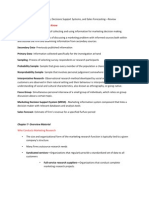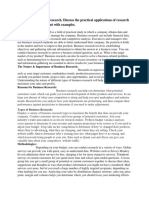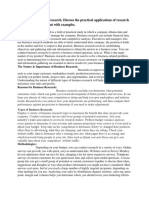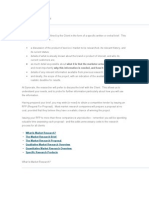Definition of Market Research
Definition of Market Research
Uploaded by
baisjyotiCopyright:
Available Formats
Definition of Market Research
Definition of Market Research
Uploaded by
baisjyotiOriginal Title
Copyright
Available Formats
Share this document
Did you find this document useful?
Is this content inappropriate?
Copyright:
Available Formats
Definition of Market Research
Definition of Market Research
Uploaded by
baisjyotiCopyright:
Available Formats
Q3]
Definition of Market Research
Written By: DJS Research Ltd, full service market research agency
Market Research is a systematic, objective collection and analysis of data about a particular target market, competition, and/or environment. It always incorporates some form of
data collection whether it be secondary research (often referred to as desk research) or primary research which is collected direct from a respondent.
The purpose of any market research project is to achieve an increased understanding of the subject matter. With markets throughout the world becoming increasingly more
competitive, market research is now on the agenda of many organisations, whether they be large or small.
The Market Research Process
To conduct market research, organisations may decide to undertake the project themselves (some through a marketing research department) or they might choose to commission it
via a market research agency or consultancy. Whichever, before undertaking any research project, it is crucial to define the research objectives i.e. what are you trying to achieve
from the research? and what do you need to know?
After considering the objectives, Market Researchers can utilise many types of research techniques and methodologies to capture the data that they require. All of the available
methodologies either collect quantitative or qualitative information. The use of each very much depends on the research objectives but many believe that results are most useful
when the two methods are combined.
Quantitative Research
Quantitative research is numerically oriented, requires significant attention to the measurement of market phenomena and often involves statistical analysis. For example, a bank
might ask its customers to rate its overall service as either excellent, good, poor or very poor. This will provide quantitative information that can be analysed statistically. The main
rule with quantitative research is that every respondent is asked the same series of questions. The approach is very structured and normally involves large numbers of
interviews/questionnaires.
Perhaps the most common quantitative technique is the ‘market research survey’. These are basically projects that involve the collection of data from multiple cases – such as
consumers or a set of products. Quantitative surveys can be conducted by using post (self-completion), face-to-face (in-street or in-home), telephone, email or web techniques. The
questionnaire is one of the more common tools for collecting data from a survey, but it is only one of a wide ranging set of data collection aids.
For further detailed information about quantitative research please click here: quantitative market research.
Qualitative Research
Qualitative research provides an understanding of how or why things are as they are. For example, a Market Researcher may stop a consumer who has purchased a particular type
of bread and ask him or her why that type of bread was chosen. Unlike quantitative research there are no fixed set of questions but, instead, a topic guide (or discussion guide) is
used to explore various issues in-depth. The discussion between the interviewer (or moderator) and the respondent is largely determined by the respondents' own thoughts and
feelings.
As with quantitative techniques, there are also various types of qualitative methodologies. Research of this sort is mostly done face-to-face. One of the best-known techniques is
market research group discussions (or focus groups). These are usually made up of 6 to 8 targeted respondents, a research moderator whose role is to ask the required questions,
draw out answers, and encourage discussion, and an observation area usually behind one way mirrors, and video and/or audio taping facilities.
In addition, qualitative research can also be conducted on a ‘one on one’ basis i.e. an in-depth interview with a trained executive interviewer and one respondent, a paired depth
(two respondents), a triad (three respondents) and a mini group discussion (4-5 respondents).
For further detailed information about qualitative research please click here: qualitative market research.
Using Market Research Data
After compiling the data, Market Researchers evaluate it and make conclusions and recommendations to their client or employer based upon their findings. They provide an
organisation's management with information needed to make decisions on the promotion, distribution, design, and pricing of products or services – information that meets the
initial research objectives.
Types of Market Research
Market research is the process of finding information
about your competitors, current market trends or your
customers. Most companies invest in market
research when they release a new product, improve
on an existing product or if they plan on introducing a
particular product in a new market.
Market research can also prove helpful if you want to
explore business opportunities in new markets.
Market research can be conducted by two methods,
primary research or secondary research.
Primary research
Primary research refers to information that is directly collected from the source. Another simple method of
primary research would be to directly talk to your customers and get their feedback. Primary research can be
both qualitative and quantitative.
1. Qualitative primary research
Qualitative primary research involves gathering information from interviews or focus groups.
Open-ended interviews include questions that cannot be answered with a yes or no. You can get a lot
of information from such interviews and also find out about the dislikes, likes, requirements, trends and
emotional motivators of your primary market
A focus group should ideally be led by experienced professionals who can lead a group of 6 or more
people and ask them both general and specific questions. Since trained professionals are required to handle
focus groups, they are very expensive
2. Quantitative primary research
Quantitative primary research involves the collection of numerical information from surveys. This information is
then analyzed.
Surveys can provide you with the information you require if the survey has meaningful questions. More
people would be willing to take a survey as it takes less time. The cheapest and easiest way of conducting a
survey is through the telephone and on the place where your product is being sold
CATI Surveys
The best way to out beat competition is to listen to your consumers. Although there are several methods of
collecting reliable data from your customers, most data collection is conducted through CATI (Computer aided
telephone interviews) which are cost-effective as well as reliable. CATI/Telephone surveys are the most
effective method of collecting data from customers.
The process of the CATI survey is based on the objective brief, survey draft, call script and the lead list that is
usually provided by the company who wants to conduct the survey. The right resources are identified and the
technology /infrastructure needed to conduct the telephone surveys allocated. The CATI surveys are then
conducted. The accuracy of the data can be measured and optimized through call center CRM technology.
CATI surveys can help you get an insight on why your customers are dissatisfied. You can also find out where
your product/service stands in comparison to competitors. Based on the feedback that you get from your
customers, you can customize your product to meet the requirements of your consumers.
Secondary market research
Secondary research is more economical and easier to do when compared to primary research. Here you will
have to analyze the information that has been collected for some other reason. You can find the data that you
require through a set of articles, demographic/ statistical data, studies etc.
By investing in secondary market research you can analyze your target markets, evaluate your competitors and
assess political, social and economic factors. The internet has a large number of secondary data sources and
most resources, magazines and press releases are now available online.
Secondary research resources
There are a large number of resources from which secondary research information can be obtained. Some of
these sources are:
1. Trade associations
From the reports available with trade associations you can get information on the industries served, the
standards that they observe and the leaders in their field. You can also get information on the latest trends,
issues and competitors.
2. The marketing departments of local colleges
The marketing department of any college can give you access to special research projects and reports
prepared by students.
3. Chamber of commerce
The local chamber of commerce in your area can give you information on your local community and local
businesses. You can also get access to the maps of the area.
4. Insurance companies, banks and real estate companies
You can information on the statistics of the communities to whom they provide services.
5. Wholesalers and manufacturers
From manufactures and wholesalers you can get information on customers, problems if any, costs, industry
standards etc
6. Libraries and other public information centers
In the reference sections of libraries and information centers you can find a lot of resource materials and data.
7. Books and publications
There are several books that can give you information on a particular type of industry or market. Trade journals
are another excellent source for information. You can also get information from government publications.
8. Magazines and newspapers
You can get a lot of information from news events and get the latest information on politics, economic indicators
etc. The archives of leading newspapers and magazines can provide you with a wealth of information. Industry
journals are another source of information.
9. Media representatives
Media representatives who work with print, audio or audio-visual media mostly collect information on the
markets that their viewers, readers and listeners are interested in.
10. Competitors
By researching on the price, products/services, brochures and reports of your competitors you can get a
greater insight on how to move forward in your business.
11. Business information centers
Such centers usually have a large collection of videos, books, CDs, publications and other information that are
helpful for small businesses.
12. Federal government resources
You can get in-depth demographic data related to the economy, market or population.
13. Regional planning organizations
If you are looking for data on a community’s past or current growth trend, you can look up the resources of
regional planning organizations.
14. Discussion groups
Discussion groups are commonly known as Newsgroups. You can get a lot of information on a variety of topics
from such groups
You might also like
- Chapter 4 Gathering Information and Measuring Market DemandDocument7 pagesChapter 4 Gathering Information and Measuring Market DemandMandy00011123322100% (1)
- Market ResearchDocument26 pagesMarket ResearchChava AnuragNo ratings yet
- Chapter 7 Marketing ResearchDocument6 pagesChapter 7 Marketing Researchsanjin19900% (1)
- Building Brand Architecture ReportDocument2 pagesBuilding Brand Architecture Reportriya100% (1)
- AbsolutDocument21 pagesAbsolutshhaldiaNo ratings yet
- This Article Has Been Updated LGBTQDocument19 pagesThis Article Has Been Updated LGBTQRaiza Sumallo Cabrera-MaratasNo ratings yet
- Marketing Research: MeaningDocument6 pagesMarketing Research: MeaningNikitha S. NairNo ratings yet
- Notes - Market ResearchDocument16 pagesNotes - Market Researchadishitole106No ratings yet
- Unit 4 Market Research Student'sDocument19 pagesUnit 4 Market Research Student'sZ INo ratings yet
- Market ResearchDocument13 pagesMarket ResearchOscar MasindeNo ratings yet
- Market Research HCDocument8 pagesMarket Research HCgaurav gharatNo ratings yet
- The Stages of Market ResearchDocument5 pagesThe Stages of Market ResearchnziiiNo ratings yet
- What Is Market Research ?Document2 pagesWhat Is Market Research ?Siddharth_Dugh_37No ratings yet
- Market ResearchDocument12 pagesMarket ResearchYor Valero'No ratings yet
- Day 7 - Market ResearchDocument9 pagesDay 7 - Market ResearchAcna RomeNo ratings yet
- Market Research 15 PDF FreeDocument26 pagesMarket Research 15 PDF FreeNung Logan100% (1)
- UntitledDocument42 pagesUntitledBee Bek BudhathokiNo ratings yet
- Chapter 1: Introduction (Market Research) : DefinitionDocument50 pagesChapter 1: Introduction (Market Research) : DefinitionAparna100% (1)
- "Consumer Research, A Part of Marketing Research Is An Applied Research" Justify The StatementDocument9 pages"Consumer Research, A Part of Marketing Research Is An Applied Research" Justify The StatementVikram SahaNo ratings yet
- Jason Fanjaya Jana MKT ResearchDocument7 pagesJason Fanjaya Jana MKT Researchaudityaeros666No ratings yet
- MR Market ResearchDocument8 pagesMR Market Researchharishkapoor83No ratings yet
- 301 Market Research AreasDocument9 pages301 Market Research AreasNishant_Bansal_3054No ratings yet
- Value of Market ResearchDocument3 pagesValue of Market ResearchTejaswini MishraNo ratings yet
- The 8 Types of Market ResearchDocument6 pagesThe 8 Types of Market Researchaprille altNo ratings yet
- Market Analysis: Market Analysis Is The First Step of Project Analysis. It Simply Estimates TheDocument10 pagesMarket Analysis: Market Analysis Is The First Step of Project Analysis. It Simply Estimates TheAamirx64No ratings yet
- Lesson-2_-Market-Research-Methods-1Document18 pagesLesson-2_-Market-Research-Methods-1NJ TolentinoNo ratings yet
- Market ResearchDocument23 pagesMarket ResearchSaleh RaoufNo ratings yet
- Summary of Key Points For Chapter 4Document6 pagesSummary of Key Points For Chapter 4Abir AllouchNo ratings yet
- TT ProjectDocument4 pagesTT ProjectzivaziamNo ratings yet
- Market Research Presentation: Prepared & Presented BY: Wafa Babikir & Omer M. EL Amin SIU 21 June 2012Document12 pagesMarket Research Presentation: Prepared & Presented BY: Wafa Babikir & Omer M. EL Amin SIU 21 June 2012Asim Abdelwahab AbdoraboNo ratings yet
- What Is Market Research?Document4 pagesWhat Is Market Research?Big LifeNo ratings yet
- Marketing Research RefDocument9 pagesMarketing Research Refajay30No ratings yet
- Market Research vs. Marketing Research - VoxcoDocument4 pagesMarket Research vs. Marketing Research - VoxcoZahid5391No ratings yet
- MARKETING MANG NOTES Unit-5 AKTUDocument16 pagesMARKETING MANG NOTES Unit-5 AKTURUBA NASIMNo ratings yet
- Business 4.4Document46 pagesBusiness 4.4samerNo ratings yet
- Q1. Explain Business Research. Discuss The Practical Applications of Research in Business Management With Examples. AnswerDocument4 pagesQ1. Explain Business Research. Discuss The Practical Applications of Research in Business Management With Examples. AnswerAhsanNo ratings yet
- Class Notes of 1425Document4 pagesClass Notes of 1425AhsanNo ratings yet
- Assignment 1Document4 pagesAssignment 1AhsanNo ratings yet
- Mwi T11Document13 pagesMwi T11pcs prasannaNo ratings yet
- unit 2 marketingDocument48 pagesunit 2 marketingSunder SimonNo ratings yet
- An Introduction To Market ResearchDocument18 pagesAn Introduction To Market ResearchShamanth GowdaNo ratings yet
- Chapter 2: Market Research The Need For Market Research: Step 1: Problem IdentificationDocument8 pagesChapter 2: Market Research The Need For Market Research: Step 1: Problem IdentificationNe Pa100% (1)
- Market Research: The Organisation Undertake A Market Research For ToDocument5 pagesMarket Research: The Organisation Undertake A Market Research For ToGanesh GiriNo ratings yet
- Basic Steps of Marketing Research Process SingmayDocument17 pagesBasic Steps of Marketing Research Process SingmaySaikat RickyNo ratings yet
- Customer Market ResearchDocument9 pagesCustomer Market ResearchTobalyntiNo ratings yet
- Session 1 ActivityDocument4 pagesSession 1 ActivityVishal PaithankarNo ratings yet
- Marketing ReseachDocument13 pagesMarketing Reseachkarlroland.blascoNo ratings yet
- Lesson 3 Conducting Market Analysis For Franchising SubjectDocument16 pagesLesson 3 Conducting Market Analysis For Franchising SubjectJengky PabuayaNo ratings yet
- Strategy 2022 - ITI-1Document91 pagesStrategy 2022 - ITI-1Mustafa NasrNo ratings yet
- Principles of Marketing Module 7Document15 pagesPrinciples of Marketing Module 7Raphael BillanesNo ratings yet
- Trial Day-3, Assessment - 1, Bikash SharmaDocument10 pagesTrial Day-3, Assessment - 1, Bikash Sharmabikash sharmaNo ratings yet
- Uk Sganalytics Com Blog What Is Market Research Complete GuideDocument20 pagesUk Sganalytics Com Blog What Is Market Research Complete GuideSimran KaushikNo ratings yet
- What Is Market ResearchDocument13 pagesWhat Is Market ResearchBenjie MariNo ratings yet
- Plan Market ResearchDocument7 pagesPlan Market ResearchMuzammil AtiqueNo ratings yet
- Lesson 2Document4 pagesLesson 2eliagracechellemaeNo ratings yet
- 3.2 - Market Research - IGCSE AIDDocument5 pages3.2 - Market Research - IGCSE AIDManeeta KaurNo ratings yet
- YEAR 9 BUSINESS STUDIES STUDY PACKDocument9 pagesYEAR 9 BUSINESS STUDIES STUDY PACKAkannaya ChiamakaNo ratings yet
- Lesson 6Document27 pagesLesson 6Jenmark JacolbeNo ratings yet
- The Market Research BriefDocument10 pagesThe Market Research BriefshahjimiNo ratings yet
- 4Document9 pages4MartaNo ratings yet
- Strategic Marketing Coordinator Manager in Vancouver Canada Resume Abigail DyDocument3 pagesStrategic Marketing Coordinator Manager in Vancouver Canada Resume Abigail DyAbigail DyNo ratings yet
- Individual Branding Vs Corporate BrandingDocument3 pagesIndividual Branding Vs Corporate BrandingMuhammad Zain Imtiyaz100% (1)
- Sponsorship Proposal: Redlands Rugby Union U15 Team - 2019 Tour To ArgentinaDocument8 pagesSponsorship Proposal: Redlands Rugby Union U15 Team - 2019 Tour To ArgentinaHNo ratings yet
- WISE International Business Directory (2002,2003)Document244 pagesWISE International Business Directory (2002,2003)FlibberdygibberNo ratings yet
- Exploratory Research Design: Qualitative ResearchDocument27 pagesExploratory Research Design: Qualitative ResearchPrakash Sharma100% (3)
- Final PPT PresentationDocument39 pagesFinal PPT PresentationHaritaa Varshini Balakumaran0% (1)
- Mts ProjectDocument101 pagesMts ProjectAmrit KrNo ratings yet
- Assessing Global Market Opportunities: InformationDocument5 pagesAssessing Global Market Opportunities: InformationSai RamNo ratings yet
- Forecasting & Demand MeasurementDocument17 pagesForecasting & Demand MeasurementMaan91No ratings yet
- Senior Executive Cover Letter, NielsenIQDocument1 pageSenior Executive Cover Letter, NielsenIQshahul.hameedNo ratings yet
- Easy ListDocument1,342 pagesEasy ListRahasia_NegaraNo ratings yet
- Brand ManagementDocument30 pagesBrand ManagementmailonvikasNo ratings yet
- Baitap StatisticsDocument2 pagesBaitap Statisticsnnanhnhi04No ratings yet
- The Big Deal 2008 Social Enterprise Business PlanDocument5 pagesThe Big Deal 2008 Social Enterprise Business PlanduttonjNo ratings yet
- MethodologyDocument35 pagesMethodologyJason BrozoNo ratings yet
- Brand Resonance Model - MBASkills - inDocument6 pagesBrand Resonance Model - MBASkills - insaiNo ratings yet
- Rahul Jain - CVDocument2 pagesRahul Jain - CVDarshan JoshiNo ratings yet
- Skoda Case StudyDocument4 pagesSkoda Case StudySubhankar Bhattacharjee100% (1)
- L'OréalDocument4 pagesL'Oréalbutterbirne87No ratings yet
- QLTR - FQ: - QL - LLSLLLDocument8 pagesQLTR - FQ: - QL - LLSLLLpratibhaNo ratings yet
- 1 Types of Brand ExtensionDocument5 pages1 Types of Brand ExtensionsteveNo ratings yet
- PR2 Planning Data Collection ProceduresDocument11 pagesPR2 Planning Data Collection ProceduresMontalban, AllesandraNo ratings yet
- CHAP 2 - Group 8Document5 pagesCHAP 2 - Group 8peteryoo12345No ratings yet
- Group 8Document8 pagesGroup 8ASHWINI KUMAR 22100% (1)
- Questionnaire Tally SheetDocument2 pagesQuestionnaire Tally SheetSuchetana SenNo ratings yet
- Global Automotive Door Latch Market Research Report 2017 PDFDocument7 pagesGlobal Automotive Door Latch Market Research Report 2017 PDFSanjay MalhotraNo ratings yet
- Herbal Essence Snag 2008 REBRAND Global AwardDocument3 pagesHerbal Essence Snag 2008 REBRAND Global Awardsherleen23No ratings yet
- Relaunching Old Brand and Reconsidering Brand Assets: Prepared By-Shruti Bose (MBAPH018001) Subject - New Product LaunchDocument31 pagesRelaunching Old Brand and Reconsidering Brand Assets: Prepared By-Shruti Bose (MBAPH018001) Subject - New Product Launchshruti boseNo ratings yet

























































































